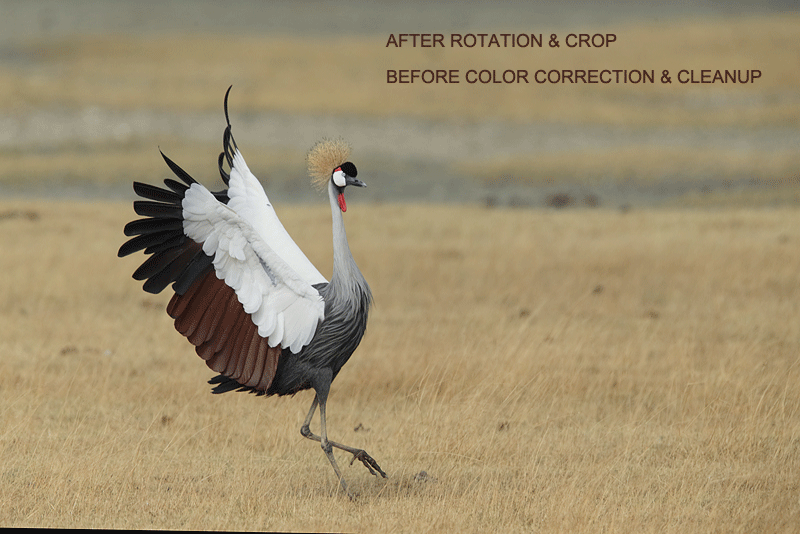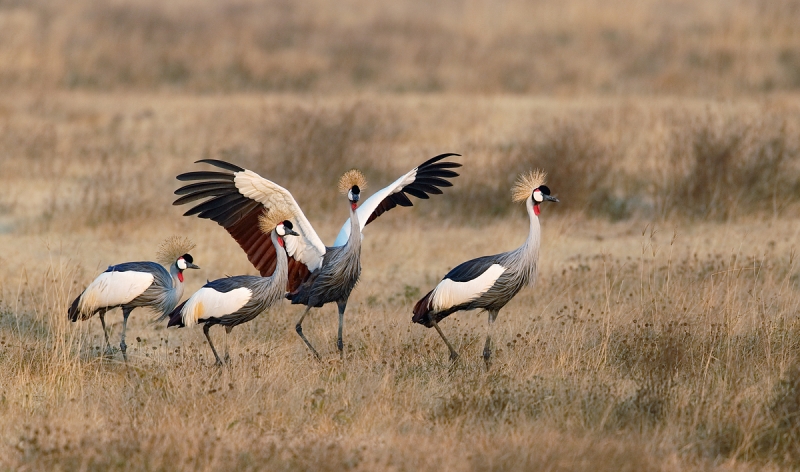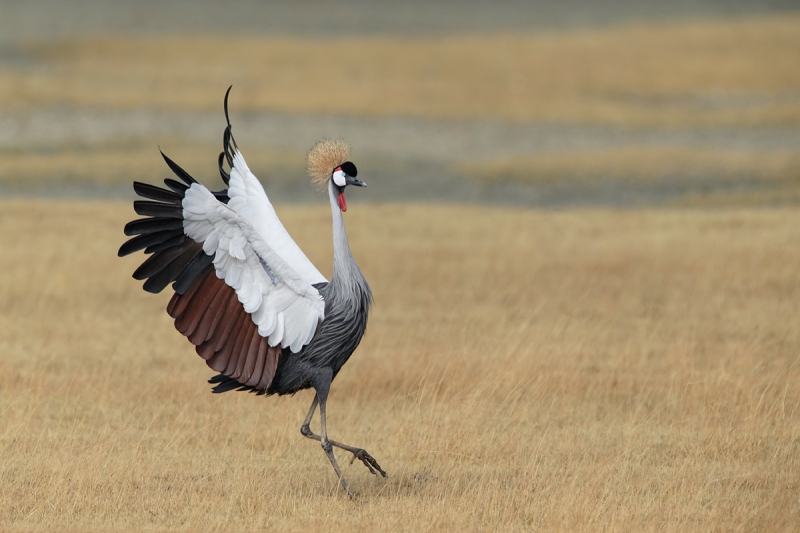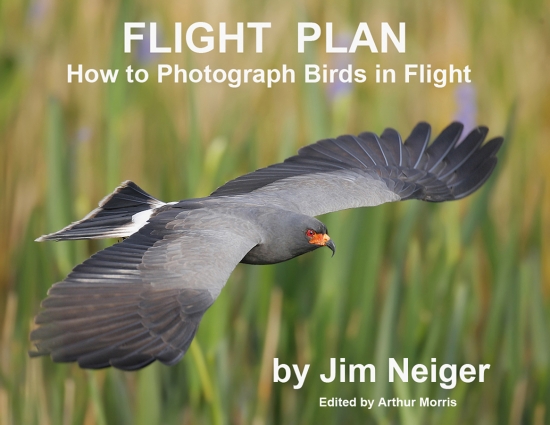|
This image of a courting group of Grey-crowned Cranes was created with the Todd-pod mounted Canon EF 600mm f/4L IS II USM lens, the Canon 1.4x EF Extender III (Teleconverter), and the Canon EOS-1D X Digital SLR camera. ISO 1250 Evaluative metering +2/3 stop: 1/1000 sec. at f/6.3 in Tv mode in very early morning light. Two sensors to the left of the central sensor/AI Servo Surround/Rear Focus AF on the base of the wing of the bird with its wings raised, active at the moment of exposure. Click here if you missed the Rear Focus Tutorial. Click on the image to see a larger version. |
Grey-crowned Crane
From the moment that I saw my first Grey-crowned Crane, on safari with Todd Gustafson, Patty Ardoin, her late husband Wes, and many others, probably in 2001, I fell in love. When I visited Tanzania fairly regularly, we did see this species fairly often, but they were somewhat hard to come by in the winter months. On the Summer Safari last August they were abundant, and best of all, they were flying around and dancing and courting. That made for exciting times at Ngorongoro Crater. I can’t wait to get back next year.
Image Quiz
#1: With focus on the crane that was farthest away, why was there enough depth-of-field (at only f/6.3) to render the closer cranes sharp?
#2: With small areas of white in the frame, why didn’t the +2/3 stop exposure compensation burn the highlights?
#3: Why Tv mode?
|
This image of a landing Grey-crowned Crane was created with the Todd-pod mounted Canon EF 600mm f/4L IS II USM lens, the Canon 2x EF Extender III (Teleconverter), and the Canon EOS-1D X Digital SLR camera. ISO 400. Evaluative metering +1/3 stop: 1/1000 sec. at f/8 in Manual mode in early morning light. Central sensor (by necessity)/AI Servo Expand/Rear Focus AF just caught the base of the bird’s neck, active–of course–at the moment of exposure. Click here if you missed the Rear Focus Tutorial. Click on the image to see a larger version. See the animated GIF below for the before and after comparison. |
World’s Most Beautiful Crane Species?
With their grey body feathers, reddish brown flight feathers, soft white wing coverts with a faint yellow wash to them, red wattles, white face ovals with the red accent above it, black caps, light blue irises, and their amazing gold crests, it is hard to image a more beautiful crane species.
If you have photographed a more beautiful crane species, we would love to hear from you.

|
The Image Optimization
After leveling and color correcting the TIFF that had been converted in Canon Digital Photo Professional (see our DPP Conversion Guide here), I cleaned up the background. Most of the distracting dark spots were zebra poop. As usual, clean-up was done with the Patch Tool, the Spot Healing Brush, and a series of small Quick Masks. I ran my NIK 50-50 only on the bird after selecting it with the Quick Selection Tool.
All of the above is detailed in our Digital Basics File. Digital Basics is an instructional PDF that is sent via e-mail. It includes my complete digital workflow, dozens of great Photoshop tips including Digital Eye Doctor techniques, several different ways of expanding canvas, all of my time-saving Keyboard Shortcuts, Quick Masking, Layer Masking and NIK Color Efex Pro basics, creating and using time-saving Actions, and tons more.
2014 Tanzania Summer Safari
If you are interested in joining us in Tanzania next summer please shoot me an e-mail and I will be glad to forward you the PDF with dates, itinerary, and price.
Flight Plan
After spending more than two months (part time) editing Jim Neiger’s great new e-Guide, Flight Plan, I learned a ton about flight photography. His explanation of the bumping the focus technique finally sunk in. Using this technique has improved my flight photography by leaps and bounds, especially when doing flight photography with an f/4 super-telephoto lens and the 2X III tele-converter (as above in the landing crane image). I remember bumping the focus as I tracked the crane on final approach and was thrilled with the sharpness of the two keepers from the short series.
You learn more about Flight Plan here or order a copy by clicking here.
First Flight Plan Feedback
Markus Jais’s paraphrased Bulletin #449 comment:
September 27, 2013 at 2:20 am
Bought Jim’s birds in flight e-guide yesterday and already read parts of it. Absolutely fantastic. The best resource out there on photographing birds in flight. Anyone interested in improving their flight photography must(!) read this. Many lessons are also helpful for other subjects like running mammals or swimming ducks. The tips on hand holding are fantastic. I often handhold my new EF 4/200-400L IS 1.4x (e.g. for marmots, swimming geese, etc) because I am faster and more flexible than with a tripod.
Many thanks to you and Jim for publishing this. I will recommend this to anyone who asks me about photographing birds in flight.
Markus
Holland Heating Up
Pending the arrival of promised checks, we now have six folks for the Touch of Holland Tulip IPT. Click here and scroll down for details.
Bosque IPTs
For information on both the 7-Day and the recently announced short version of the 2013 Bosque IPTs please click here and scroll down.
Support the BAA Blog. Support the BAA Bulletins: Shop B&H here!
We want and need to keep providing you with the latest free information, photography and Photoshop lessons, and all manner of related information. Show your appreciation by making your purchases immediately after clicking on any of our B&H or Amazon Affiliate links in this blog post. Remember, B&H ain’t just photography!


Amazon
Everyone buys something from Amazon, be it a big lens or deodorant. Support the blog by starting your search by starting your search by clicking on the logo-link below. No purchase is too small to be appreciated; they all add up. Why make it a habit? Because I make it a habit of bringing you new images and information on an almost daily basis.
Typos
On all blog posts, feel free to e-mail or leave a comment regarding any typos, wrong words, misspellings, omissions, or grammatical errors. Just be right. 🙂

















Cannot order the Neiger book. Your Website has been non-functional for this order for two days. Telephone Jim, please. I would like the book but do not like sitting for hours for the website to progress.
Hi Joel, Thanks for your note. Sorry that you are having problems in the store. Please e-mail Jim your phone number at birdsasart@verizon.net or give us a call today at 863-692-0906. Yours is the first problem of this type that we have heard of; about 150 folks have successfully purchased the book via the store. artie
Hi Artie,
I’ve been reading your blog for a couple of months as my interest in bird photography has grown, it’s been a great source of knowledge. Thanks for sharing.
To answer your questions about the Grey-crowned Cranes:
1. The farther the subject distance, the greater the depth of field. You were far enough away to produce deep enough DOF (I’d guess the subject was about 125′ away which would be about 1.4′ of DOF in front of the subject, farther would only increase the front DOF)
2. Early morning light requires more exposure because the scene is overall a lighter tone.
3. TV mode used to set a fast enough shutter speed to freeze the birds
Arnie:
Love your shots of the Grey-crowned cranes, as I love all your images. My images of the cranes come no where close to yours of course.
As an aside, these cranes are considered “endangered”. “Although the Grey Crowned Crane remains common over much of its range, it faces threats to its habitat due to drainage, overgrazing, and pesticide pollution. Their global population is estimated to be between 58,000 and 77,000 individuals. In 2012 it was uplisted from Vulnerable to Endangered by the IUCN.”
So many animals, especially African ones, including lions, rhinos, leopards, secretary birds may not be with us much longer.
I hope your African IPT people know how lucky they are to see all these animals as their grandchildren might not be able to enjoy some of them.
Keep up the great work !!!
Jim
Hi Jim,
Thanks for dropping by and for your kind words, and for the info the status of the cranes. artie
#1: Per Jim, @840mm the DOF is large enough at the distance to the birds. Is the Circle of Confusion the principle you were looking for? I don’t remember exactly, is it something like 40% of the in focus area is in front of the focus point and 60% behind the focus point.
#2: I’m not real familiar with Tv but does this cause the metering to be related to the focus point? This was the base of the wing which is white so the auto exposure would have been too dark so more light was needed.
#3: Your primary concern was stopping the action so you wanted to control the shutter speed. The other factor is the changing light as the birds move around and the sun comes up. Tv lets the camera adjust Aperture and ISO to optimize the equipments capabilities.
On question 1, let me guess that all 4 cranes are on the arc of a circle with the camera at the center, and so the other 3 weren’t really closer, even though they occupy a plane that was closer to the camera than the plane occupied by the first one. Can’t think of anything else that would account for it; even my 400 f/5.6L has salami-thin DOF at f/6.3.
Don’t know 2 and 3; I’ve never been able to figure out how to make Tv work.
Love the images.
Artie,
It’s interesting to compare your 2nd crane photo to mine
(http://danstreiffert.smugmug.com/Tanzania/Birds-of-Tanzania/i-Z8cNK7d)
taken at nearly the same time and place with my 500 + 1.4 * 1.6 = 1120 mm lens.
Your DOF isolates the crane much nicer.
All it takes is a new camera & lens. About the price of a trip to Africa…
I’m still working on my photos. It was a great trip!
Dan
Love these birds. We saw them in Tanzania and Zambia and had lots of fun photographing them. Your optimized image is very nice.
P.S. I only unsubscribed from your Bulletin and Bolg to change my email address. I resubscribed using my current email. (Just so you know what was going on there)
1> Even at an “840mm f/6.3” the cranes were far enough away that the DOF was enough to render the closer cranes sharp.
2> There are not many very dark areas in the image to move the exposure toward trying to shift them towards that “medium grey” that auto exposure likes.
3> The cranes were moving quickly while displaying and you needed to stop the action.
A very nice image. Thanks for all you publish here.
Hi Jim, With regards to #1, can you state the principle that applies? I will withhold judgement on the other two answers for now 🙂